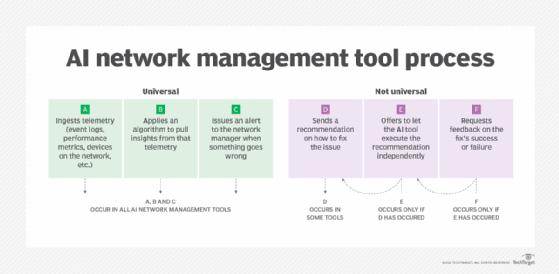
your123 - stock.adobe.com
AIOps in networking helps but can't solve complex problems
The AIOps tools offered by network management vendors are good at solving routine problems but lack the intelligence to address complicated issues, customers said.
Companies are finding that the AI tools in network management systems fail to solve enough problems reliably and independently from the intelligence gathered by the software.
The use of AIOps technology in networking is growing within enterprises. The tool set taps big data, machine learning, predictive analytics and advanced algorithms to identify and resolve common IT issues like mismatched VLAN assignments or outdated firmware.
Those corrections are not trivial, but AI will have to do much more to speed up adoption on a larger scale, companies said.
Wireless broadband provider WeLink and the College of William & Mary, a public research university, criticize and applaud the AI tools in their network management systems (NMS). The technology quickly and easily aggregates and correlates network data but fails in other tasks, they said.
William & Mary picked Juniper Networks' Mist three years ago to gain immediate and historical network visibility. The college's nine-person IT department supports its Wi-Fi network and virtual learning and meeting tools while acting as the students' ISP in residence halls. With so much work and so few workers, network managers depend on Mist to provide actionable intelligence out of 850 switches and 2,800 access points, said Norman Elton, director of IT infrastructure.
"[Mist] collects data very quickly," Elton said. "They aggregate it, they report on it, and the reports that they give you, the tools they give you, are relevant and tangible for people investigating Wi-Fi problems."
Unfortunately, Mist AIOps doesn't solve problems more difficult than detecting anomalies or spotting physical problems like failed cabling or downed RADIUS servers, Elton said. He added that he wants more advanced AI technology to provide bug alerts that arrive before an impact on the network, suggests and schedules fixes such as a firmware update, and then asks him for confirmation before proceeding with the correction.
"We see vendors touting their magical AI, but when we implement it so far, it's been fairly simplistic," Elton said.
Early this year, WeLink deployed startup Selector Software's network analytics and monitoring product to more efficiently complete simple, data-intensive tasks. Among other things, WeLink wanted to correlate outages with network change logs and create baselines for the temperatures in its radios to spot anomalies, said Mike Hoyt, senior vice president of network engineering.
The time Selector's technology saved was the equivalent of two full-time network engineers, Hoyt said. Because he needed fewer people to accomplish the same tasks, WeLink used the freed time to build a 24/7 network operations center in just eight months.
"We couldn't have gotten there without [Selector's AI tools]," Hoyt said. "When we were on a traditional NMS, we would have [needed] a lot more heads, and it just wouldn't have been feasible."
But network automation needs to go even further, Hoyt said. Like Elton, he said he wants AI tools to resolve typical network problems without human intervention. But Hoyt said he wouldn't trust Selector's product to act independently yet.
The technology needs more development time before it can offer reliable recommendations based on a complete understanding of WeLink's Network, Hoyt said.
"How many times out of 100 that [Selector] told us an interface needed to be shut down did it really need to be shut down?" he said. "When that gets to, you know, five-nines, then we can turn on [automation]."

Hoyt and Elton are not alone in their complaints. A 2021 Enterprise Management Associates survey of 309 IT professionals rated predictive analysis as the No. 1 area IT professionals wanted to see AIOps tool vendors improve, followed by root cause analysis.
Sabur Mian, CEO of IT reseller STN, said he doesn't expect demand for AI networking tools in small and midsize enterprises to increase in the foreseeable future, until the tools get more robust. However, he added that he expects service providers to push vendors hard for better automation as the complexity of their networks rises.
"Being able to provide a better, faster path to Netflix, a service provider or a content provider is where I see the future for AI in network management," Mean said. "You want to be able to make those [routing] decisions automatically."
Vendors are trying to meet customer demand. Cisco recently launched a predictive networking engine that uses AI to spot degrading network paths before they affect people or devices. The company made the tool available last month through ThousandEyes WAN Insights.
In a recent interview, ThousandEyes co-founder and general manager Mohit Lad discussed plans to build automation capabilities that self-correct WAN path selection.
Juniper recently announced Mist and Marvis updates that validate AP placement and simplify Dynamic Host Configuration Protocol and wired authentication troubleshooting. The incremental improvements reflect a strategy of gradually increasing the number of problems Juniper's AI technology can solve.
"That's really what attracted us to Mist -- not because their magical AI is all that and a bag of chips," Elton said. "It's moving in that direction, so it's worth investing in that platform to see where it goes."
Madelaine Millar is a news writer covering network technology at TechTarget. She has previously written about science and technology for MIT's Lincoln Laboratory and the Khoury College of Computer Sciences, as well as covering community news for Boston Globe Media.






